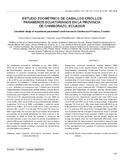| dc.rights.license | http://creativecommons.org/licenses/by-nc-sa/3.0/ve/ | es_VE |
| dc.contributor.author | Larrea-Izurieta, Carlos Octavio | |
| dc.contributor.author | Oñate-Mancero, Francisco Javier | |
| dc.contributor.author | Paredes-Orozco, Manuel Patricio | |
| dc.date.accessioned | 2018-11-05T22:13:58Z | |
| dc.date.available | 2018-11-05T22:13:58Z | |
| dc.date.issued | 2018 | |
| dc.identifier.issn | 0798-2259 | |
| dc.identifier.uri | http://www.saber.ula.ve/handle/123456789/45354 | |
| dc.description.abstract | Se compararon zoometrías realizadas en los años 2005 y 2014 en el biotipo caballar de la comunidad San Antonio
de Guayllabamba, provincia de Chimborazo, Ecuador, para establecer la variación zoométrica durante este período de
tiempo, como efecto de recomendaciones de selección realizadas en 2005. Se utilizaron reportes de 28 equinos analizados en 2005
y 35 en 2014, con características fenotípicas de biotipo criollo. Se midieron 12 variables y 7 índices zoométricos a los que se
sometió a estadística descriptiva (media, valor máximo y mínimo y error estándar), se compararon con T-Student para muestras
independientes y frecuencias de perfiles cefálico, cervical, dorsolumbar, ventral e isquio-ilíaco. Se reporta promedios entre ambas
poblaciones para longitud y ancho de cabeza 51,6 cm (± 0,4) y 19,6 cm (± 0,12), respectivamente, alzadas a la cruz 126,6 cm
(± 0,75) y grupa 127,6 cm (± 0,74), ancho y largo de grupa 44,1 cm (± 0,38) y 44,2 cm (± 0,34) correspondientemente, diámetro
longitudinal 131,4 cm (± 0,89), profundidad y ancho de pecho 59,8 cm (± 0,49) y 32,3 cm (± 0,49) en su orden, perímetros:
torácico 149,1 cm (± 1,11) y de caña 16,5 cm (± 0,15), peso vivo 268,1 kg (± 5,68). Se concluye que los promedios de zoometrías
encontradas en animales estudiados en 2014 superan a los analizados en 2005 en todas las medidas, a excepción del
perímetro torácico y peso vivo; pese a lo escrito, la estadística no reporta diferencias significativas, se puede inferir que la mejora
en las medidas zoométricas se debió a que los criadores han desarrollado los ajustes al manejo y selección de reproductores
recomendados previamente. | es_VE |
| dc.language.iso | es | es_VE |
| dc.publisher | SaberULA | es_VE |
| dc.rights | info:eu-repo/semantics/openAccess | es_VE |
| dc.subject | Equinos | es_VE |
| dc.subject | Morfometría | es_VE |
| dc.subject | Zoometría | es_VE |
| dc.subject | Perfiles | es_VE |
| dc.subject | Indices zoométricos | es_VE |
| dc.title | Estudio zoométrico de caballos criollos parameros ecuatorianos en la provincia de Chimborazo, Ecuador | es_VE |
| dc.title.alternative | Zoometric study of ecuadorian paramount creole horses in Chimborazo Province, Ecuador | es_VE |
| dc.type | info:eu-repo/semantics/article | es_VE |
| dcterms.dateAccepted | 29/05/2018 | |
| dcterms.dateSubmitted | 17/10/2017 | |
| dc.description.abstract1 | Researchers compared zoometries realized between 2005 and 2014 years in the equine biotype of the San Antonio de
Guayllabamba Community, Chimborazo Province, Ecuador, to establish the zoometric variation during this period of time, as a
result of selection recommendations made in 2005. Reports of 28 equines analyzed in 2005 and 35 in 2014 with phenotypic
characteristics of Creole biotype were used. It was measured 12 variables and 7 zoomometric indices to which descriptive statistics
were subjected (mean, maximum and minimum value and standard error), were compared with T-Student for independent
samples and frequencies of cephalic, cervical, dorsal-lumbar, ventral profiles and ischio-iliac. Averages were reported between
both populations for head length and width 51.6 cm (± 0.4) and 19.6 cm (± 0.12), respectively, raised to the cross 126.6 cm (±
0.75) and rump 127.6 cm (± 0.74), width and croup length 44.1 cm (± 0.38) and 44.2 cm (± 0.34) correspondingly, longitudinal
diameter 131.4 cm (± 0 , 89), chest depth and width 59.8 cm (± 0.49) and 32.3 cm (± 0.49) in order, perimeters: thoracic 149.1 cm
(± 1.11) and cane 16.5 cm (± 0.15), live weight 268.1 kg (± 5.68). It is concluded that the averages of zoometries found in animals
studied in 2014 exceed those analyzed in 2005 in all measures, except for the thoracic perimeter and live weight, despite the
writing, the statistic does not report significant differences, it can be inferred that the improvement in the zoometric measures was
due to the fact that the breeders have developed the adjustments to the management and selection of previously recommended
breeding animals. | es_VE |
| dc.description.colacion | 257-264 | es_VE |
| dc.description.email | colirbba@hotmail.com | es_VE |
| dc.identifier.depositolegal | pp199102ZU46 | |
| dc.identifier.edepositolegal | ppi201502ZU4665 | |
| dc.identifier.eissn | 2477-944X | |
| dc.publisher.pais | Venezuela | es_VE |
| dc.subject.institucion | Universidad del Zulia (LUZ) | es_VE |
| dc.subject.institucion | Universidad de Los Andes (ULA) | es_VE |
| dc.subject.keywords | Equine | es_VE |
| dc.subject.keywords | Morphometric | es_VE |
| dc.subject.keywords | Zoometric | es_VE |
| dc.subject.keywords | Profiles | es_VE |
| dc.subject.keywords | Zoometric indexes | es_VE |
| dc.subject.publicacionelectronica | Revista Científica | |
| dc.subject.thematiccategory | Medio Ambiente | es_VE |
| dc.subject.tipo | Revistas | es_VE |
| dc.type.media | Texto | es_VE |


